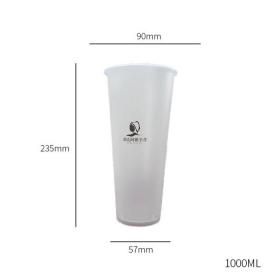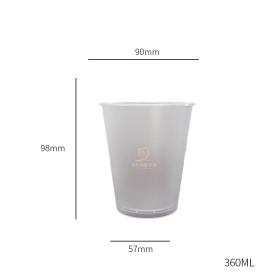The PP cup, with its advantages of lightness, durability and low cost, has become a common choice for daily drinking and takeout packaging. However, the material properties determine specific limitations and potential risks in its usage. Understanding and following the correct usage methods is crucial for ensuring health and safety and prolonging the service life.

Firstly, it is essential to strictly control the types of contents and temperature ranges that can be placed in the PP cup. Although food-grade PP material has certain heat resistance, it should not be directly filled with boiling water or kept for a long time in hot beverages. Otherwise, it may cause the cup to soften and deform, or even release trace amounts of plasticizers. In particular, it is necessary to be vigilant about the prolonged contact of acidic beverages or high-fat foods with high-temperature conditions, as this will accelerate the degradation of the polypropylene molecular chains and the penetration of oils through the cup wall, resulting in odor residue and material deterioration. Moreover, it is absolutely forbidden to use the PP cup to hold corrosive liquids such as industrial solvents, strong acids, and strong bases. These substances will quickly damage the plastic structure and produce toxic by-products.
The part of the PP cup marked "Microwave Compatible" can be heated briefly in the microwave, but the cup lid and sealing ring must be removed first. The majority of PP cup lids are made of PE or PET materials, and their heat resistance is much lower than that of the cup body. They are prone to melting and deforming under microwave radiation. During heating, the power and duration must be strictly controlled. Each heating session should not exceed 1 minute, and ensure there is sufficient liquid in the cup to prevent local overheating from causing the cup to warp or release harmful substances. Special attention should be paid that the printed patterns on the surface of the PP cup may transfer heavy metal pigments from the ink to the food when heated in the microwave.
Although the material of the PP cup has some toughness, repeated dropping or excessive squeezing can still cause cracks in the cup wall and cup mouth breakage. When using, avoid directly hitting hard objects with the cup body and prevent stacking under heavy pressure when loading. The scraping of sharp objects will leave scratches on the cup wall. These microscopic damages not only breed bacteria but also reduce the structural strength of the cup. For cup lids with suction holes, confirm the matching of the suction tube and the hole position. If it is too tight, it may crack the cup lid due to forced insertion, especially in low-temperature environments where the material becomes brittle and is more prone to damage.

It is recommended to rinse the PP cup immediately after each use with a neutral detergent, focusing on cleaning the threaded part of the cup mouth and the sealing groove of the cup lid, etc., where stains are likely to remain. Stubborn tea stains or coffee deposits can be treated by soaking in a baking soda solution. Do not use abrasive cleaning tools such as steel wool or detergent powder. Disinfection should preferentially choose steam or boiling methods. If using a disinfection cabinet, avoid the high-temperature drying mode. Chemical disinfectants should be diluted strictly according to the ratio. After disinfection, be sure to thoroughly rinse to avoid chemical reactions with the subsequent beverages.
| Category | Do | Don't |
|---|---|---|
| Contents | Use liquids ≤80°C | Pour boiling water |
| Limit acidic/oily food exposure | Store corrosive chemicals | |
| Microwave | Remove lid before heating | Microwave printed cups |
| Medium power ≤1 minute with liquid | Heat empty cups or with lids | |
| Handling | Avoid drops and impacts | Use sharp utensils inside |
| Match straw size to lid hole | Force straw insertion in cold conditions | |
| Cleaning | Wash immediately with mild detergent | Use abrasive scrubbers |
| Disinfect below 80°C | Soak in strong disinfectants |